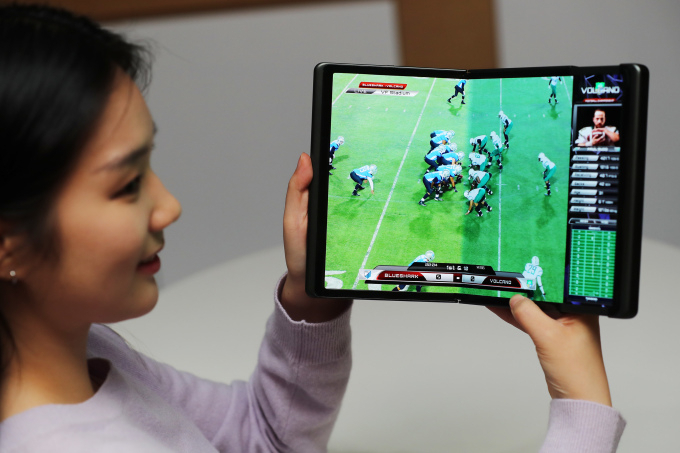China outpaces Korea in smaller OLED shipments for 1st time
With Samsung’s unrivaled dominance, experts call for Korean display makers to widen gap in high-end products
By Jo He-rimPublished : April 29, 2024 - 16:23

China outpaced Korea in the shipment of organic light-emitting display panels for IT gadgets for the first time in the first quarter of this year, stirring concerns that Korean manufacturers could eventually be pushed out of the market by Chinese rivals.
According to Chinese market tracker Cinno Research on Monday, China's OLED shipments for IT gadgets including smartphones and tablet PCs accounted for 53.4 percent of the total in the January-March period, ahead of Korea’s 46.6 percent.
The Chinese figure increased by 15.6 percent on-year.
By company, Samsung Display retained its leadership with a 41 percent market share, even though its shipments decreased by 12.3 percent on-year.
Chinese display makers followed in the list, with BOE Technology at 17.5 percent, Visionox at 11.6 percent and CSOT at 10.1 percent. Tianma, another Chinese firm, took 9 percent, while Korea's LG Display took 6 percent.
On the latest statistics, market watchers here said the Chinese shipment is largely targeting the domestic demands, and that they would have limited influence on Korean display makers.
"It is important to understand that a large portion of China's shipments cover domestic demand. Chinese IT companies and smartphone suppliers are strategically choosing to use Chinese OLED panels," UBI Research CEO Yi Choong-hoon said.
Chinese smartphone makers, such as Huawei, Xiaomi, Vivo and Oppo, are introducing OLED panels for their latest smartphones, but they appear to be sourcing them from Chinese manufacturers.
According to the Korea Display Industry Association, the share of OLED panels supplied by Korean display makers to Chinese smartphone manufacturers was 56 percent in 2022, but the figure dropped to 16 percent in 2023.
The "patriotic" consumer sentiment also affected the sales of Apple in China. In the fourth quarter of last year, Apple's iPhone took 24 percent of the country's market share, but the figure dropped to 15 percent in the first quarter of this year. Samsung Display and LG Display are the major OLED panel suppliers for Apple.
Yi underscored how Korean display makers hold a technological edge in OLED panel production, and that Korea still dominates the OLED market in terms of revenue.
"It is true that Chinese companies like BOE are getting better at producing OLED panels. But OLED products vary depending on their quality, and Chinese firms are targeting the cheaper low-end segment," Yi said.
"I believe the impact of China's shipment would be limited for Korean firms excelling in high-end panels."
In 2023, South Korea took 71.6 percent of the global sales of OLED panels for IT gadgets, while China took 27.6 percent.
In the global OLED market, Korea took 74.2 percent of the market share in terms of revenue, while China posted 25.1 percent.
Samsung Display is seen ramping up its OLED business for IT gadgets. The company kicked off the construction of its new 8.6-generation IT OLED panel production line capable of producing 10 million laptop panels in Asan, South Chungcheong Province last month.
For the new manufacturing facility, the display maker announced a 4.1 trillion won ($3.1 billion) investment by 2026.
China's BOE also announced to invest $8.84 billion to build an 8.6-generation OLED display production line for IT gadgets in Chengdu, China.
Samsung Display, LG Display and BOE Technology are also seen vying to get OLED panel orders from Apple for its new iPhone SE 4, expected to launch in 2025.
Samsung Display Chief Executive Officer Choi Joo-sun, who doubles as the head of the Korea Display Industry Association, said the trend of wider OLED adoption among IT devices will continue, and the burgeoning market will require higher technological prowess.
While Choi admitted Korean display makers are “on an uneven playing field” competing against Chinese rivals strongly supported by their government, he expressed confidence that Korea would retake the No. 1 position in the display market by 2027.
According to Omdia, a market tracker, the global IT OLED market is expected to grow from $2.5 billion in revenue in 2024 to $8.9 billion in 2029, at an annual growth rate of 28.6 percent.



![[KH Explains] Hyundai Motor’s plan for new landmark keeps hitting bumps](http://res.heraldm.com/phpwas/restmb_idxmake.php?idx=644&simg=/content/image/2024/05/13/20240513050626_0.jpg&u=20240513192803)

![[Grace Kao] American racism against Stray Kids](http://res.heraldm.com/phpwas/restmb_idxmake.php?idx=644&simg=/content/image/2024/05/13/20240513050827_0.jpg&u=)













